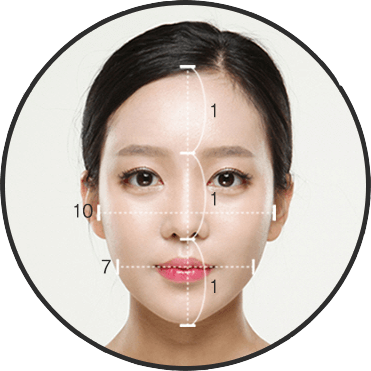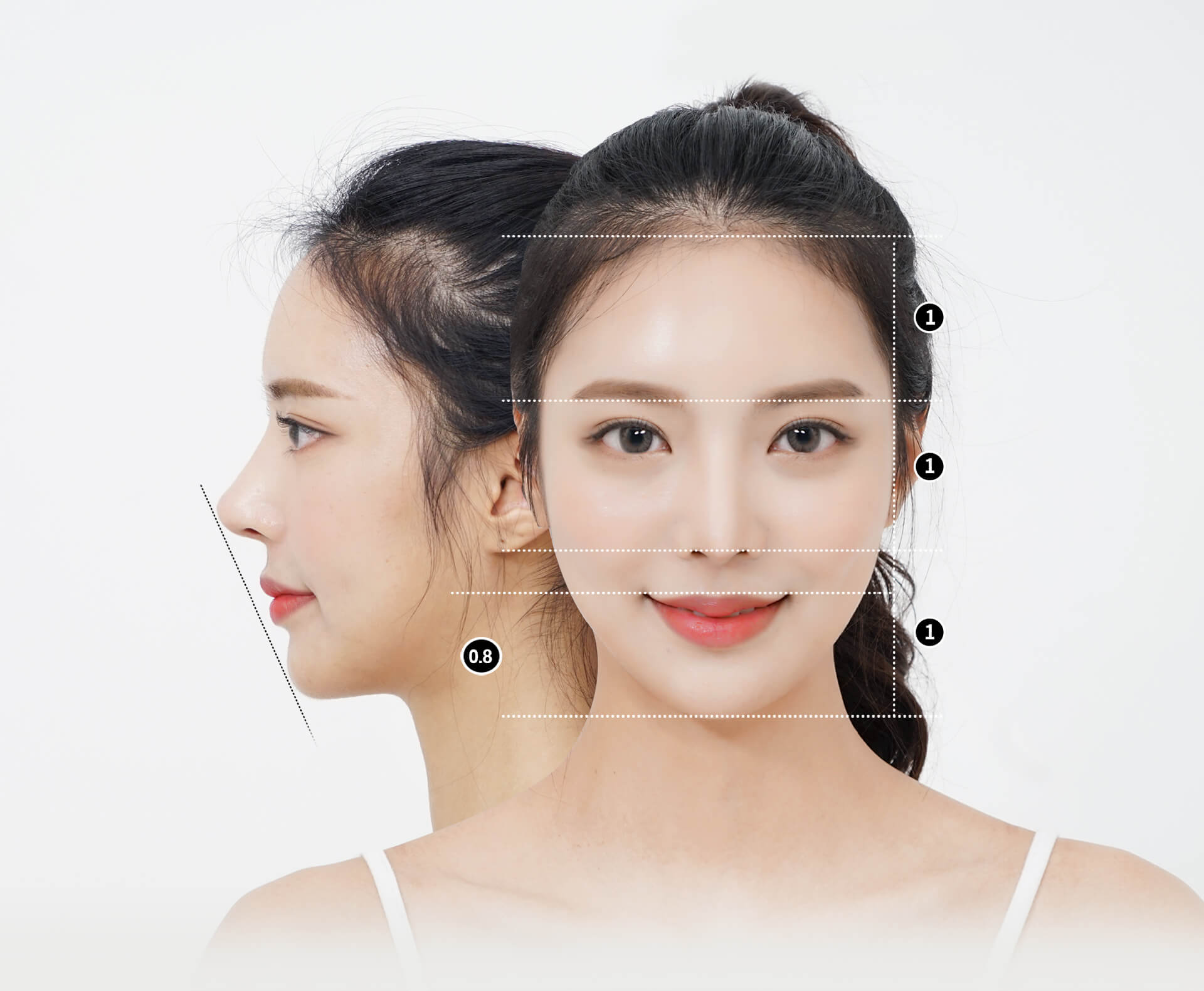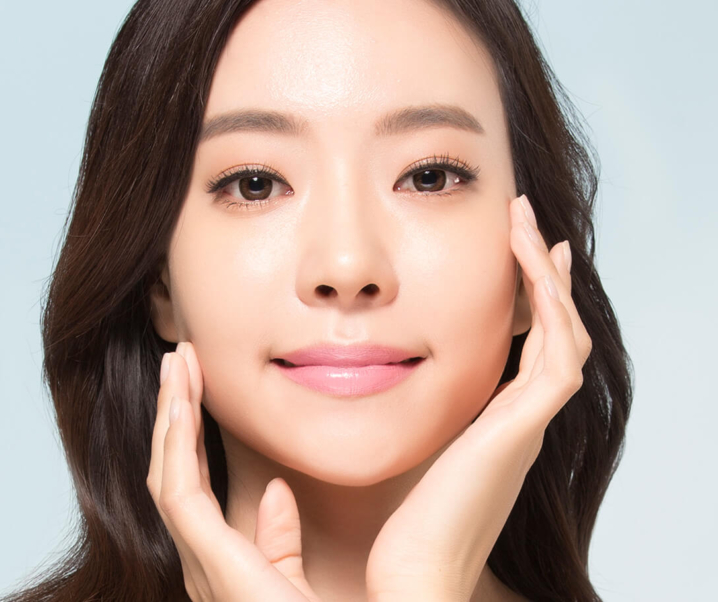In contrast to Western beauty standards where accentuated cheekbones and jawlines are preferred, the ideal face shape coveted by most Asians, especially the Koreans, are a slim, symmetrical face with a v-shaped jaw.
Because in general, having a angular face shape actually makes a person look more masculine and intimidating. On the other hand, having a small, slender and v-shaped jawline makes one look more feminine, younger and approachable. However, many Asians are born with square or angular jawlines, so many turn to V-line surgery to get a v-shaped jaw. Read on to learn more about v-line surgery in Korea.
Golden ratio for the perfect V-line face

- Golden ratio for overall face shape – forehead to eyebrow to tip of nose to chin is 1:1:1.
- Width of jawline should be 0.7 times of the width of cheekbones.

- Optimal ratio of nose tip to chin is 1:0.8.
- Straight line from the tip of your nose to your lips to your chin, when viewed from your side profile.
What is Korean V-line surgery?
Typically, the Korean V-line surgery consists of a set of facial contouring surgeries – mainly square jaw reduction surgery, genioplasty (chin augmentation) and sometimes, cheekbone reduction surgery.
These jawline surgeries aims to enhance the appearance of your lower face by reshaping your jawline from a “U” shape to a more feminine “V” shape. These procedures specifically targets your existing bone structure and is suitable for those who want to correct:
- Wide and round lower jaws
- Angular or square jaws
- Long or asymmetrical jaws
- Protruding jaws
Plastic surgery procedures involved in Korean V-line surgery
The typical V-line surgery only involves square jaw surgery and genioplasty, but sometimes, other facial contouring surgeries might be necessary in order to achieve your coveted jawline. These are the procedures involved in a Korean V-line surgery:
1. Square jaw reduction surgery
Square jaw reduction surgery aims to reduce the width of the lower face, and at the same time, alters a square and angular jaw into a slimmer, v-shaped jaw. This procedure is for those who have:
- Square jaws which make them look too masculine
- Overly angular jaws which makes their face look wide
- Asymmetrical jawline
Overly prominent jawlines are caused by either overdeveloped jaw muscles (due to too much chewing or clenching), your bone structure, or both. Especially when caused by bone structures, getting a square jaw reduction is the most effective way to get rid of angular and square jaws.
2. Genioplasty
Genioplasty or chin augmentation is performed to enhance the appearance and shape of the chin by fixing specifically the frontal part of your jawbones. It is for those who have:
- Receding or weak chins
- Small chins that creates the appearance of a double chin
- Short chins
- Protruded chins
- Overly long chins
However, if your chin is too small or too short, there are insufficient bones available to lengthen or correct your chin deficiencies. In such cases, chin implants are necessary.
3. Cheekbone reduction surgery
Cheekbone reduction, also known zygoma reduction, is a plastic surgery procedure that reshapes overly protruding cheekbones. Its purpose is not to flatten or remove your cheekbones but rather, to reshape them to reduce facial width while also giving your face a more 3D projection that suits your overall facial contours.
Signs that your cheekbones are overly prominent for your face:
- Your face width is wide, with your mid-face especially wide.
- When looking at your front view, your high cheekbones make your face look uneven.
- The area under your cheekbones looks dented in and sunken.
- Your face looks flat and wide because of your large cheekbones.
In fact, cheekbones have a three-dimensional structure – frontal cheekbones, 45° cheekbones, and side (lateral) cheekbones. So proportionately angled cheekbones can add dimension and give your face a beautiful contour.
Benefits & risks of Korean V-line surgery
The benefits of a Korean V-line surgery include:
- Giving you a slimmer and v-shaped jawline
- Balances your facial features
- Giving you a softer and more contoured jawline
- Facial harmony from your side profile
- Correcting jaw asymmetries
- Making you look more feminine and younger
And as with all other surgical procedures, it does come with some side effects and risks of its own. Side effects and risks include:
- Droopy or saggy skin at jawline – occurs if excessive bones are removed but can be fixed with treatments such as thread lift, SMAS facelift or full face lift
- Irreversible results when too much bones are cut off
- Risk of nerve damage if your surgeon is not skilled enough
How long does Korean V-line surgery take?
Typically, V-line surgery in Korea takes 2~3 hrs and is performed under general anesthesia.
When can I see results?
Major bruising and swelling (about 70%) will last 2~3 weeks and actual results are seen after 3 months. After surgery, you will be wearing a facial bandage to help compress swelling. Make sure to keep it on for at least 1 week, or as advised by your surgeon.
During the healing period, dental care is extremely important in order to avoid infections. Do not use your jaw muscles excessively or open your mouth too big for at least 1-2 months.
Do take note that the success of your v-line surgery not only lies in the hands of your surgeon but also how you well you recover after surgery. So learn how to properly care for yourself during the recovery period by reading our article on facial contouring surgery aftercare and post-op instructions.
Actual recovery time vary among individuals, and is subjected to one’s health condition & healing response.
How long should I stay in Korea?
V-line surgery in Korea is considered a major surgery, and might sometimes require hospitalization for a day. But definitely stay in Korea until your stitches are removed. And go shopping in the meantime!
Stitch removal
Stitch removal is done 10~14 days after surgery.
Cautions on stitch removal
If you remove the stitches earlier then advised, your wound might reopen, causing an infection. But if you remove it too late, you risk further scarring and pigmentation.
Don’t rush the recovery procedure for best results!
Due to time constraints, you might consider to remove your stitches at the local hospitals in your home country. Although it is possible (but not recommended), it is subjected to your doctor’s approval, and your healing progress.
Alternatives to Korean V-line surgery
Other alternatives to Korean V-line surgery surgery includes jaw botox and chin fillers. Jaw botox can help shrink your jaw muscles slightly while chin fillers or fat injections can help contour your chin.
However, results of such non-surgical procedures are only temporary and will not be effective if the cause of your square jaw or flat chin is due to your existing bone structure.
Conclusion
Your facial proportions very much influences how you look. And having balanced facial proportions can greatly enhance your facial features. With a slender and v-shaped face, you will look much younger as well as more feminine.
And despite V-line surgery being a high risk surgery, many still opt to go for it. But take note that V-line surgery requires extreme precision in order to achieve symmetrical results and avoid any nerve damage on the jaw.
That’s why it is very important for you to get a highly skilled doctor who is experienced in facial contouring surgeries. Not to mention, adequate rest during the recovery period as well as strict implementation of your surgeon’s post-op instructions.
anti-aging cosmetic surgeryanti-aging plastic surgeryanti-aging procedurechin augmentationchin surgery in koreacosmetic surgery in koreajaw surgery in koreaKorean face contouring surgerykorean jaw surgerykorean v-line surgeryplastic surgery in koreav-line surgery in korea









What do you think?